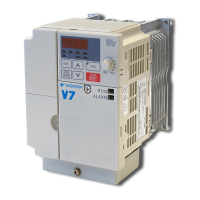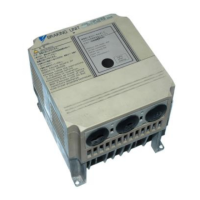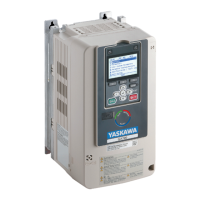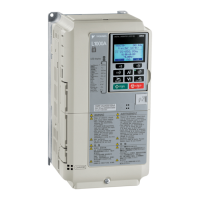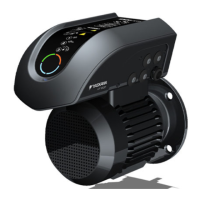Troubleshooting
6
6.4 Fault
YASKAWA SIEPC71061723A YASKAWA AC Drive CR700 Technical Manual 357
Code Name Causes Possible Solutions
Overload occurred while running at low speed. • Decrease the load when running at low speed.
• Raise the motor speed.
• If the motor is run frequently at low speeds, either replace it
with one that is a size larger or use a drive dedicated motor.
Note:
If a general-purpose motor is used, overload may occur while
running at low speed even when operating at below the rated
current.
L1-01 [Motor Overload Protection Select] is not set
correctly.
Set L1-01 in accordance with the motor characteristics if a drive
dedicated motor is used.
The V/f pattern does not fit the motor qualities. • Examine the ratios between the V/f pattern frequency and
voltage. Decrease the voltage if it is too high compared to the
frequency.
• Adjust E1-04 to E1-10 [V/f Pattern Parameters]. For motor 2,
adjust E3-04 to E3-10 [V/f Pattern for Motor 2]. Decrease the
values set in E1-08 [Mid Point A Voltage] and E1-10
[Minimum Output Voltage].
Note:
If E1-08 and E1-10 are set too low, the overload tolerance will
decrease at low speeds.
Set E1-06 [Base Frequency] correctly. Set E1-06 correctly to the rated frequency that indicated on the
motor nameplate.
Multiple motors are running off the same drive. Set L1-01 = 0 [Motor Overload Protection Select = Disabled],
and then configure a circuit to protect the motors by connecting a
thermal overload relay to each motor.
The characteristics of the electronic thermal
protector and the characteristics of the motor
overload do not match.
• Examine the motor characteristics and set L1-01 [Motor
Overload (oL1) Protection] correctly.
• Connect a thermal overload relay to the motor.
The electronic thermal protector is operating at the
wrong level.
Set E2-01 [Motor Rated Current (FLA)] correctly to the value
specified by the motor nameplate.
Motor loss due to overexcitation operation is
increasing.
• Lower the value set in n3-13 [Overexcitation Deceleration
Gain].
• Set L3-04 ≠ 4 [Decel Stall Prevention Selection ≠
Overexcitation/High Flux].
• Set n3-23 = 0 [Overexcitation Operation Select = Enabled in
both directions].
The output current is fluctuating due to input power
supply phase loss.
Make sure that there is no phase loss, and repair problems.
Note:
• The drive detects this fault if the electronic thermal protector of the drive triggered the motor overload protection.
• Do a Fault Reset to clear the fault.
Code Name Causes Possible Solutions
oL2 Drive Overload
The load is too heavy. Decrease the load.
The acceleration/deceleration time or cycle time is
too short.
• Examine the acceleration/deceleration times and the motor
start/stop frequency (cycle time).
• Increase the values set in C1-01 to C1-08 [Acceleration/
Deceleration Time].
The V/f pattern does not fit the motor qualities. • Examine the ratios between the V/f pattern frequency and
voltage. Decrease the voltage if it is too high compared to the
frequency.
• Adjust E1-xx [V/f Pattern Parameters] settings. Decrease the
values set in E1-08 [Mid Point A Voltage] and E1-10
[Minimum Output Voltage]. For motor 2, adjust E3-xx [V/f
Pattern for Motor 2] settings. Decrease the values set in E3-08
[Motor 2 Mid Point A Voltage] and E3-10 [Motor 2 Minimum
Output Voltage]. For motor 3, adjust E7-xx [V/f Pattern for
Motor 3] settings. Decrease the values set in E7-08 [Motor 3
Mid Point A Voltage] and E7-10 [Motor 3 Minimum Output
Voltage].
Note:
If Ex-08 and Ex-10 are set too low, the overload tolerance will
decrease at low speeds.
The drive capacity is too small. Replace the drive with a larger capacity model.
Overload occurred while running at low speed. • Decrease the load when running at low speed.
• Replace the drive with a larger capacity model.
• Decrease the value set in C6-02 [Carrier Frequency
Selection].
Torque compensation gain is too large. Decrease the value set in C4-01 [Torque Compensation Gain] so
that the motor does not stall.
The output current is fluctuating due to input power
supply phase loss.
• Examine for wiring errors or disconnected wires in main
circuit drive input power, and repair problems.
• Make sure that there is no phase loss, and repair problems.
Note:
• The drive detects this fault if the electronic thermal protector of the drive started the motor overload protection.
• Do a Fault Reset to clear the fault.
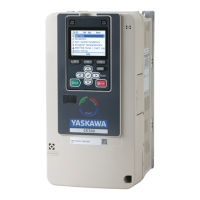
